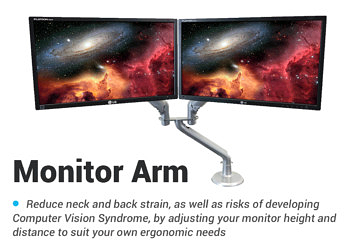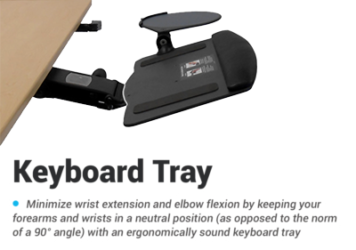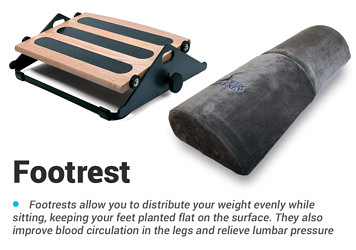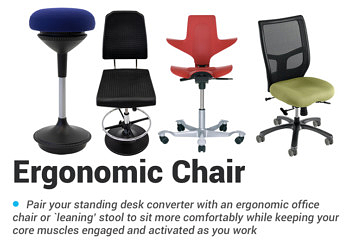FlexiSpot Comhar Standing Desk Review
- Preview

Overview
| Review Summary |
This desk is made for a laptop user who doesn’t have specific ergonomic needs like a keyboard tray or monitor arm. Options and weight capacity are minimal, and it, unfortunately, comes with a crossbar running between the legs right where your feet want to be. It’s a good value for those who don’t mind the drawbacks because of its price, easy assembly and built-in drawer and USB ports. |
|---|---|
| MSRP / List Price | $340 |
| Street Price |
Glass top: $420 |
| Shipping |
Free shipping in the lower 48 states |
| Warranty |
Frame: 5 years |
| Lift Type |
Single stage electric lift |
| Sizes Available |
The Comhar comes in one size only: 47.3” x 23.7” |
| Colors Available |
Black, Maple or White for wood top |
| Monitor Arm Mounting Options |
It is not practical to install a monitor arm on this desk due to the thick desktop (and fragility of the glass top) |
| Adjustment Range |
Height range: 28.3” – 47.6” |
| Weight Capacity |
99 lbs |
| Dimensions |
Desktop thickness: 2″ |
| Typical Assembly Time |
Once components are removed from the packaging, assembly time should be about 15 minutes. One tool (an Allen key) is included for attaching the lifting columns to the desktop and the feet to the lifting columns. No other tools are required. See assembly video |
| ANSI/BIFMA Certified |
No |
| NEAT™ Certified by Mayo Clinic |
No |
| Competition |
Compare to All Top-Rated Standing Desks
|
| Where to buy |
Buy on FlexiSpot |
Rating
| Ease of Assembly | |
|---|---|
| Customer Experience | |
| Quality and Aesthetics | |
| Ergonomics | |
| Innovation | |
| Value | |
| Positives | The built-in drawer is fairly large and will definitely help. It has three built-in USB ports accessible from the front of the desk. The assembly is quick and easy, with only three steps and one included tool required. |
| Negatives | There's an unappealing crossbar down by the feet that definitely gets in the way. The thick desktop that has a built-in drawer, doesn't allow for a keyboard tray or ergonomic monitor arm, so it's best for laptop users. There's only one size available. With all the heavy hardware in the desktop the remaining weight-lifting capacity is low for a modern-day standing desk. |
Bottom Line
This is a “first look” synopsis on the FlexiSpot Comhar. A full review is coming soon!
One of the few standing desks with built-in drawers we’ve seen, the FlexiSpot Comhar brings plenty of unique selling points to the table, but, as we noted in our reviews of the FlexiSpot Esben and FlexiSpot’s Theodore, a drawer on a standing desk is both a bonus and an obstacle for ideal ergonomics.
It’s a bonus, because standing desk storage is hard to come by and the FlexiSpot Comhar drawer’s dimensions (26.2”x12.4”x1.57”) are right in line with basic add-on drawers, albeit on the very shallow end of the spectrum with only an inch and a half of vertical depth.
It’s an obstacle for ergonomics, because you can’t install a keyboard tray or monitor arm on this desk due to the thick desktop. That’s not just our opinion, FlexiSpot discloses this on their own product page.

This is the third desk of this style that we’ve looked at, following the iMovR Captain’s Desk and the FlexiSpot Theodore. The Captain’s Desk is a piece of solid-wood designer furniture that’s in a very different price range, while the Theodore is the same price (depending on which top you pick for the Comhar) and has a more traditional style as opposed to the Comhar’s modern aesthetic.
The Comhar seems like a solid desk for the price, but FlexiSpot eats away at some of that goodwill by stretching claims in several spots, most notably when it comes to a warranty it refers to as “industry-leading.” With a 5-year warranty on the frame, two years on the electronics and two years on the desktop, this is not an industry-leading warranty. iMovR, Fully and UpLift all have recently expanded their desk warranties to up to 15 years.
FlexiSpot also markets this desk as kid-friendly in multiple spots on their product page because it goes down to 28.3”. This is an interesting idea, but what happens when it’s time for the kids to sit down? Or for that matter any shorter user. The ANSI/BIFMA standard is for the minimum height of a desk to reach down to 22″ in order to be usable by 95 percent of seated-female users. Most standing desks go down to at least 25″, with the last three inches achievable by installing an ergonomic keyboard tray, which is something you can’t do anyway on the Comhar and Theodore desks.
Even if you are targeting a standing desk with a low enough height range for kids, there are desks that reach much lower, like the UpLift V2-Commercial that goes down to 22.6”.
Electric Lifting Base Design is a Throwback to the Last Decade
So how does Flexispot cram so many features into a single desk at this price point? Well, the short answer is that the made-in-China lifting base skimps massively on components.
The lifting legs are of a single-stage design (two tube segments instead of the usual three that you’d find in a more robust dual-stage base) and it literally uses only one motor to lift both legs. You can’t make an electric lifting base any cheaper.
The transmission rod that drives both legs up and down in sync places a lot of load on the small motor and is reminiscent of manual crank adjustable-height desks we used to review nearly a decade ago. It is yesteryear technology but if you don’t want to pay more than $400 for a standing desk this is what you’re going to get. The single-stage columns also mean the height adjustment range is very small—only 19 inches—making the Comhar unsuitable for the shortest and tallest of users, and ideal only for medium-height male users.
Also reminiscent of manual standing desks is the crossbar at the bottom of the base. This is something we also stopped seeing in standing desks almost a decade ago (though the UpLift V2 Commercial and Geekdesk still employ them on their Jiecang bases to compensate for low-quality componentry). Nearly all standing desks have moved the crossbars up to the underside of the desktop where they are out of visual view and not obstructive to users’ feet or shins.
So even with the 2″-thick metal desktop on the Comhar presumably providing a lot of stability to the desk frame, it apparently still needs a crossbar at the bottom to strengthen the “parallelogram” of the entire desk. This is an indication of poor quality lifting legs that exhibit too much “deflection” and need the band-aid of a low crossbar (See our primer on Why Some Standing Desks Shake More Than Others). At the end of the day, it’s cheaper for these Chinese manufacturers to throw in a piece of crossbar metal than to build lifting columns with precision glides. In sharp contrast, you won’t find any American-made standing desks using a low crossbar as a crutch for attaining reasonable stability.
The other consequence of the underpowered motor is the nominal 99-pound lifting capacity of this desk. This may not be an issue for users who aren’t going to be installing heavy monitors and monitor arms, but it is something to be aware of as low lifting capacities tend to run with low reliability and durability of the motor. See our primer on Do Weight Ratings on Electric Desks Really Matter?
Comhar or Theodore?
The Comhar shares some of the negatives we saw with the Theodore. It only has one desktop size. The weight capacity is not great. The particleboard desktop construction leaves it vulnerable to damage.
It carries over a couple of big assets from the Theodore as well: three built-in USB ports and an easy assembly.
Other than the styling, the biggest visual difference between the Theodore and Comhar is the Comhar’s low crossbar that goes from leg to leg just above the feet. In modern standing desks, a crossbar is a sign of less-than-ideal design. It also gets in the way. Crossbars are known as “shin crushers” or “knee crushers” for a reason. This Comhar crossbar should perhaps be known as a “foot crusher” because it’s so close to the ground. This placement won’t cause you to hit it much more, but hit it with your feet instead of your shin.
Because of this crossbar, we’d definitely recommend the Theodore over the Comhar, if you’re picking between FlexiSpot standing desks with drawers, unless the appearance differences between the two sway you.
The Takeaway
With the Comhar, it all comes down to how you’ll use the desk and if the drawbacks will bother you. If you’re using it for a laptop, don’t care about the ergonomic advantages of a monitor and keyboard tray, or don’t care about the crossbar, this desk brings a lot of interesting advantages for the price. This is a clear case of you get what you pay for, however, with the short warranty (despite Flexispot claiming it is “industry-leading”). The componentry in this desk is chosen for the lowest cost and lowest shipping weight; we would not expect a long, useful life out of the desk, as reflected in the minimal warranty coverage.
One thing that’s also noteworthy about the Comhar, is that it is also sold through Home Depot. So if it’s in stock at your nearest store, that may be a great benefit in terms of not having to wait more than a few hours to pick one up. Call ahead to your local store, though, to make sure it’s in stock. Many items that Home Depot lists are only sold online these days.
We have gathered all our reviews on FlexiSpot products in one place, if you want to buy specifically from them for some reason. There you can find their top desks like the Esben, Theodore, E1L L-Shaped desk, classic E1, quick assembling Vici, Willow, Seiffen, and the larger E4L L-Shaped desk.
If the storage possibilities in a desk are what you are looking for, see our other reviews on desks with built-in storage options.
Many standing desks and converters come with grommets for some added convenience. Check out our article on grommet holes for everything you need to know about the different ways to use them to enhance your workstation, what to look for in your grommet holes, and where to find the desks with the best ones.





0 Comments
Leave a response >